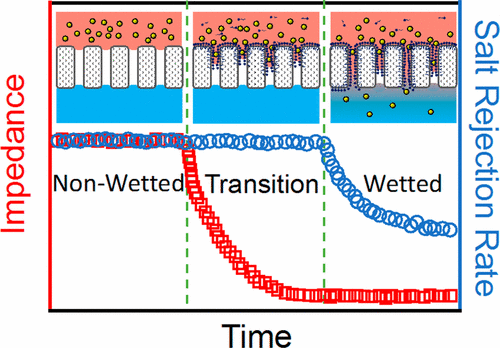当前位置:
X-MOL 学术
›
Environ. Sci. Technol. Lett.
›
论文详情
Our official English website, www.x-mol.net, welcomes your
feedback! (Note: you will need to create a separate account there.)
Probing Pore Wetting in Membrane Distillation Using Impedance: Early Detection and Mechanism of Surfactant-Induced Wetting
Environmental Science & Technology Letters ( IF 8.9 ) Pub Date : 2017-10-03 00:00:00 , DOI: 10.1021/acs.estlett.7b00372 Yuanmiaoliang Chen 1 , Zhangxin Wang 1 , G. Kane Jennings 2 , Shihong Lin 1, 2
Environmental Science & Technology Letters ( IF 8.9 ) Pub Date : 2017-10-03 00:00:00 , DOI: 10.1021/acs.estlett.7b00372 Yuanmiaoliang Chen 1 , Zhangxin Wang 1 , G. Kane Jennings 2 , Shihong Lin 1, 2
Affiliation

|
Pore wetting is an important failure mechanism unique to membrane distillation (MD). The existing approach of wetting detection based on distillate conductivity works only when a membrane has failed in the presence of fully wicked-through pores. In this study, we develop a novel and simple method, based on measurement of cross-membrane impedance, for monitoring the dynamics of membrane pore wetting and enabling early detection of imminent wetting-based membrane failure. Using Triton X-100 to induce pore wetting in direct contact MD experiments, we demonstrated the rapid response of single-frequency impedance to partial pore wetting long before any change in distillate conductivity was observed. We also conducted an MD experiment using alternating feed solutions with and without surfactants to elucidate the mechanism of surfactant-induced pore wetting. Our experimental observations suggest that surfactant-induced pore wetting occurred via progressive movement of the water–air interface and that adsorption of surfactants to the membrane pore surface plays an important role in controlling the kinetics of progressive wetting.
中文翻译:

使用阻抗探测膜蒸馏中的孔润湿:表面活性剂诱导的润湿的早期检测和机理
孔润湿是膜蒸馏(MD)独有的重要失效机理。现有的基于馏出物电导率的润湿检测方法仅在存在完全毛细孔的膜发生故障时才起作用。在这项研究中,我们基于跨膜阻抗的测量,开发了一种新颖而简单的方法,用于监测膜孔润湿的动态,并能够及早检测出即将发生的基于润湿的膜破坏。在直接接触MD实验中,使用Triton X-100诱导孔隙润湿,我们证明了在观察到馏出物电导率发生任何变化之前,单频阻抗对部分孔隙润湿的快速响应。我们还进行了MD实验,使用了有或没有表面活性剂的交替进料溶液,以阐明表面活性剂引起的孔润湿的机理。我们的实验观察表明,表面活性剂引起的孔润湿是通过水-空气界面的逐步移动而发生的,并且表面活性剂对膜孔表面的吸附在控制逐步润湿的动力学中起着重要作用。
更新日期:2017-10-03
中文翻译:

使用阻抗探测膜蒸馏中的孔润湿:表面活性剂诱导的润湿的早期检测和机理
孔润湿是膜蒸馏(MD)独有的重要失效机理。现有的基于馏出物电导率的润湿检测方法仅在存在完全毛细孔的膜发生故障时才起作用。在这项研究中,我们基于跨膜阻抗的测量,开发了一种新颖而简单的方法,用于监测膜孔润湿的动态,并能够及早检测出即将发生的基于润湿的膜破坏。在直接接触MD实验中,使用Triton X-100诱导孔隙润湿,我们证明了在观察到馏出物电导率发生任何变化之前,单频阻抗对部分孔隙润湿的快速响应。我们还进行了MD实验,使用了有或没有表面活性剂的交替进料溶液,以阐明表面活性剂引起的孔润湿的机理。我们的实验观察表明,表面活性剂引起的孔润湿是通过水-空气界面的逐步移动而发生的,并且表面活性剂对膜孔表面的吸附在控制逐步润湿的动力学中起着重要作用。











































 京公网安备 11010802027423号
京公网安备 11010802027423号